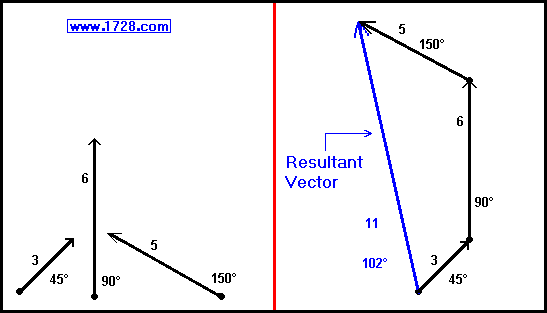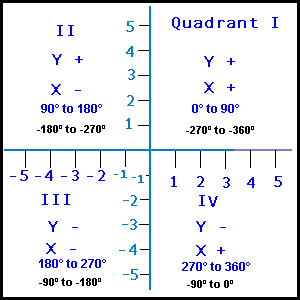For the vector addition CALCULATOR, click here.
Scalar quantities have magnitude only. (Examples are temperature and volume).
Vector quantities have magnitude and direction. (Examples are velocity and force).
Physically Adding Vectors
In the below left diagram, we see 3 vectors with their associated magnitudes and angles. In order to add these, we always must connect vectors ‘head to tail’ and the resultant vector (which represents the vector sum) is drawn from the tail of the first vector to the head of the last vector (see right side of the diagram below). In this example, using a ruler and protractor, we are able to get a resultant vector of about magnitude 11 and an angle of 102°.

In the above example, we demonstrated adding vectors physically by drawing and measuring them. In the real world, we need much greater accuracy. (However, you learned the important concept of visualizing vector addition).
Adding Vectors Mathematically
In this section, we will add the same vectors mathematically . To do this, we first must resolve each vector into its horizontal and vertical components.
![vector2[1]](https://wp.1728.org/wp-content/uploads/2024/03/vector21.png)
We see from the graphic on the left that:
X = Horizontal Component = Magnitude * Cos (θ)
Y = Vertical Component = Magnitude * Sin (θ)
(Note: In this diagram, the angle is represented by the Greek letter θ or ‘theta’. In mathematics and science, angles are usually labeled as such).
X= 3 * Cos(45°)
X= 3 * 0.707106781186547… = 2.12132034355964
Y = 3 * Sin(45°)
Y = 3 * 0.707106781186547… = 2.12132034355964
![vector3[1]](https://wp.1728.org/wp-content/uploads/2024/03/vector31.png)
Moving on to the next vector:
In this case, there is no horizontal component.
X = 6 * Cos(90°)
X = 6 * 0 = 0
Y = 6 * Sin(90°)
Y = 6 * 1 = 6
![vector4[1]](https://wp.1728.org/wp-content/uploads/2024/03/vector41.png)
And for the final vector:
X = 5 * Cos(150°)
X = 5 * -0.866025403784439 = -4.33012701892219
Y = 5 * Sin(150°)
Y = 5 * .5 = 2.5
Now we sum up the horizontal components (the X values):
X sum = 2.12132034355964 + 0 -4.33012701892219 = -2.20880667536255
Summing up the vertical components (the Y values):
Y sum = 2.12132034355964 + 6 + 2.5 = 10.62132034355964
We determine the magnitude of the resultant vector by the Pythagorean Theorem:
Magnitude 2 = X2 + Y2
Magnitude 2 = -2.208806675362552 + 10.621320343559642
Magnitude 2 = 4.87882692912616 + 112.812445840514
Magnitude 2 = 117.69127276964
Magnitude = 10.848560861683
10.62132034355964
-2.20880667536255)
Now, we’re just one step away from determining the vector’s direction.
At this point we have to be careful in choosing the correct angle for the resultant vector.

Another way to determine the quadrant in which the resultant vector points is to look at the arctangent formula. This formula divides the ‘Y’ value by the ‘X’ value. So if ‘Y’ and ‘X’ are positive, it is Quadrant I. If ‘Y’ is positive and ‘X’ is negative, (as is the case for this example) the vector head points to Quadrant II. So, we are certain that the answer is